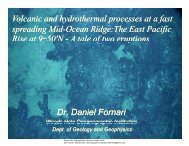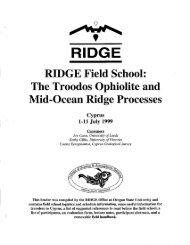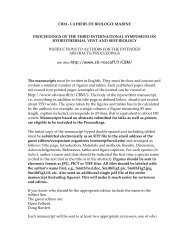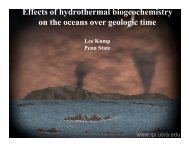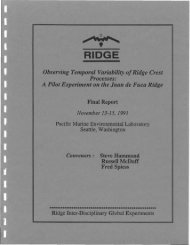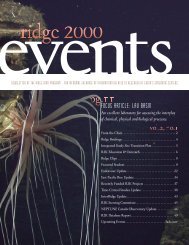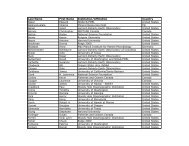You also want an ePaper? Increase the reach of your titles
YUMPU automatically turns print PDFs into web optimized ePapers that Google loves.
control the genesis of many types of seafloor ore deposits that<br />
are analogous to those found on land. <strong>Ridge</strong> crest venting of<br />
seawater provides the ultimate energy source to support unique<br />
chemosynthetic biological communities on mid-ocean spreading<br />
centers. Interactions with circulating seawater strongly affect<br />
the geometry and external dynamics of axial magma chambers,<br />
resulting in some of the topographic and morphological variability<br />
seen on ridge segments. The injection of vent water into<br />
the ocean by hydrothermal activity has implications for ciculation<br />
patterns. A detailed understanding of the individual<br />
physical and chemical processes that constitute a hydrothermal<br />
system will provide insight into many problems in biological,<br />
chemical, geological. and physical oceanography. While current<br />
research on seafloor hydrothermal circulation has begun to<br />
address a few of these problems, new approaches and a more<br />
focused effort will be required to achieve an interdisciplinary<br />
view.<br />
Four broad areas about which future hydrothermal system<br />
research might center can be outlined. First. the physical<br />
mechanisms of heat transfer from magma chambers or hot rock<br />
into hydrothermal systems must be identified. Second, the<br />
geometry of hydrothermal plumbing and the permeability structure<br />
of the crust must be delineated. Third, information must<br />
be gathered about the temporal variability of hydrothermal<br />
systems. Finally, the spatial variability and tectonic associations<br />
of hydrothermal systems must be more clearly defined.<br />
All of these objectives involve a mixture of basic exploratory<br />
research with more focused, detailed investigations using new<br />
technologies and imaginative approaches.<br />
OBJECTIVE 5: To determine the interactions of organisms with<br />
physical and chemical environments at mid-ocean ridges.<br />
The discovery and subsequent studies of unique biological<br />
communities associated with hydrothermal vents along the midocean<br />
ridge system have altered drastically many traditional<br />
views of biological processes and adaptations on this planet.<br />
In these hydrothermal environments, the energy source is chemical<br />
rather than solar, with chemosynthetic bacteria rather<br />
than photosynthetic plants at the base of the food chain.<br />
Many of the dominant animals at the vents have incorporated<br />
these bacteria within their tissues, resulting in unusual<br />
symbiotic adaptations that are now proving to be far more<br />
widespread throughout the entire Earth's biosphere than<br />
originally imagined. Some bacteria in these environments<br />
survive temperatures well above the range once thought<br />
tolerable for living organisms, and continuing studies of<br />
such microbial adaptations will be of fundamental importance<br />
to our understanding of the basic structure of living matter.<br />
Further definition of the extent to which chemosynthetic bacteria<br />
affect the chemistry of vent fluids is essential to a<br />
8






